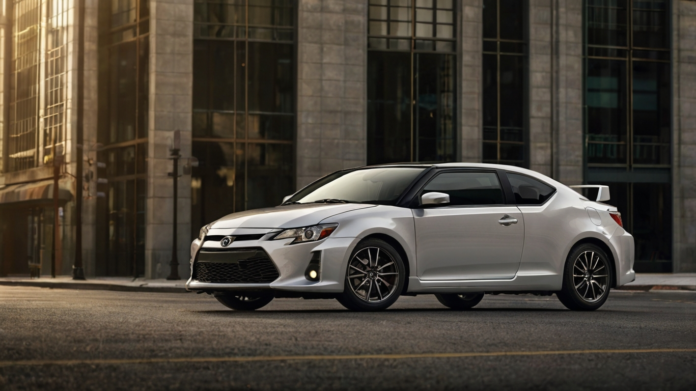The Toyota Scion tC is more than just a sporty coupe; it’s a symbol of affordability, practicality, and style that resonated with younger car buyers during its production years. With its blend of performance, modern design, and customization options, the Scion tC carved a niche for itself in the compact sports car segment.
History of the Scion tC
Launch of the Scion Brand
Toyota introduced the Scion brand in 2003, aiming to attract younger buyers with affordable and stylish vehicles. The tC, launched in 2004 for the 2005 model year, quickly became a standout in the lineup.
First Generation (2005-2010)
The first-generation Scion tC featured a 2.4-liter inline-4 engine, delivering 161 horsepower. It offered a sleek coupe design with a panoramic sunroof, making it a unique choice in its segment.
Second Generation (2011-2016)
The second generation brought sharper styling and a more powerful 2.5-liter engine producing 179 horsepower. Enhanced technology and improved handling further solidified its appeal.
Design and Exterior Features
Sporty Yet Practical Design
The Scion tC struck a balance between sporty aesthetics and everyday practicality. Its two-door coupe design was complemented by a spacious interior and wide-opening doors for easy access.
Key Exterior Elements of the First Generation
The first-generation model featured clean lines, a wide stance, and a distinctive grille. Its panoramic glass roof was a standout feature, offering an open-air feel.
Updates in the Second Generation
The second-generation tC adopted a more aggressive look with angular headlights, a bolder grille, and enhanced aerodynamics.
Interior and Comfort
Cabin Layout and Seating
Inside, the Scion tC offered a driver-focused cockpit with comfortable bucket seats and quality materials. Rear passengers enjoyed more space than typically found in compact coupes.
Technology and Features
Both generations came equipped with modern technology, including premium audio systems, Bluetooth connectivity, and optional navigation systems.
Cargo Space and Utility
With its hatchback design, the Scion tC offered excellent cargo capacity, making it more practical than most coupes.
Performance and Engine Specifications
Engine Options Across Generations
The first-generation tC featured a reliable 2.4-liter engine, while the second generation upgraded to a 2.5-liter powerplant for better performance.
Transmission Choices
Buyers could choose between a 5-speed manual or a 4-speed automatic in the first generation, and a 6-speed manual or automatic in the second generation.
Driving Dynamics and Handling
The tC’s low center of gravity and sport-tuned suspension delivered a fun and responsive driving experience.
Fuel Efficiency
MPG Ratings for Both Generations
The Scion tC achieved respectable fuel economy, averaging around 23 MPG city and 31 MPG highway for the second generation.
Factors Influencing Fuel Economy
Driving habits, maintenance, and modifications could significantly impact fuel efficiency.
Aftermarket Potential
The Scion tC became a favorite among tuners for its customization potential. From turbo kits to body kits, owners could transform their vehicles to suit their style and performance needs.
Safety Features and Ratings
Both generations featured advanced safety measures, including anti-lock brakes, stability control, and multiple airbags. The tC also performed well in crash tests, earning high safety ratings.
Market Appeal and Target Audience
The Scion tC’s blend of affordability, style, and reliability made it a top choice for young drivers and first-time car buyers.
Scion tC in Pop Culture
The Scion tC frequently appeared in car enthusiast events, video games, and aftermarket showcases, cementing its status as a beloved model.
Discontinuation of the Scion tC
In 2016, Toyota discontinued the Scion brand, transitioning some models under the Toyota badge. Unfortunately, the tC was not among them, marking the end of its production.
Buying a Used Scion tC
When buying a used tC, consider its maintenance history, mileage, and potential modifications. Common issues include worn suspension components and oil consumption in older models.
Comparing the Scion tC to Competitors
While the Honda Civic Coupe offered similar reliability, the tC’s customization options set it apart. The Hyundai Veloster’s unique three-door design and the Ford Focus’ sportier trims were also notable competitors.
Owner Reviews and Community Feedback
Owners appreciated the tC’s versatility, sporty design, and affordability. Some criticisms included road noise and a lack of power compared to competitors.
Legacy of the Scion tC
The Scion tC left a lasting impression on the compact sports car market. Its blend of practicality, style, and customization potential remains unmatched in its price range.
Conclusion
The Toyota Scion tC remains a symbol of a well-executed compact sports coupe that balanced performance, practicality, and affordability. Even after its discontinuation, it continues to inspire loyalty among its fans and enthusiasts.
FAQs
- Is the Scion tC a reliable car?
Yes, the Scion tC is known for its reliability, especially with regular maintenance. - What is the average price of a used Scion tC?
Prices vary by model year and condition but typically range between $8,000 and $15,000. - Does the Scion tC require premium fuel?
No, the Scion tC runs efficiently on regular unleaded gasoline. - Can the Scion tC be easily modified?
Absolutely! The tC is popular in the aftermarket community for its wide range of customization options. - What are common problems with the Scion tC?
Common issues include oil consumption in older models and suspension wear over time.
You May Read This Article Aslo 180 c to f



